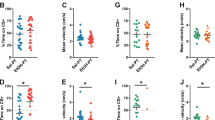Abstract
A single-trial place conditioning procedure, one treatment and one non-treatment during two daily conditioning sessions followed by a single test session on the 3rd day, was used to examine the place conditioning effects of intracerebrally administered nicotine. In the first series of experiments, Sprague-Dawley male rats were implanted unilaterally with guide cannulas aimed at the lateral ventricle. After 1 week, rats received either “treatment” (nicotine in 2 µl phosphate buffer or 2 µl of buffer alone) or “no treatment” (no injections) before being placed in the black or white compartment of a three-compartment place-conditioning apparatus for 20 min. The next day the rats received the opposite treatment before being conditioned in the opposite compartment. On day 3, animals had free access to the entire apparatus for 15 min and the time spent in each compartment was recorded automatically. Even though the rats exhibited a baseline bias for the black compartment, intracerebroventricular nicotine induced positive place preferences relative to buffer control, i.e. if treatments were paired with the black compartment, nicotine enhanced the preference for the black compartment, and if the treatments were paired with the white compartment, nicotine induced a preference for the white compartment. In addition, the nicotine-induced preference response was antagonized by the co-intraventricular administration of mecamylamine. In a second series of experiments, animals were implanted unilaterally with guide cannulas aimed at the pendunculopontine tegmental nucleus of the mesopontine tegmentum. Nicotine microinjection, 1.2–18.5 nmol in 0.5 µl buffer, induced a dose-dependent positive place preference response. The place preference induced by 18.5 nmol nicotine was antagonized by co-administering 0.8 nmol mecamylamine; 0.8 nmol mecamylamine had no effects of its own. Finally, microinjections of 18.5 nmol nicotine 2 mm dorsal to the pedunculopontine tegmental nucleus did not condition place preferences. These data demonstrate that a sensitive site of action of the nicotine-conditioned place preference response in rats is within the mesopontine tegmentum.
Similar content being viewed by others
References
Clarke PBS, Fibiger HC (1987) Apparent absence of nicotine-induced conditioned place preference in rats. Psychopharmacology 92:84–88
Fudala PJ, Iwamoto ET (1986) Further studies on nicotine-induce d conditioned place preference in the rat. Pharmacol Biochem Behav 25:1041–1049
Fudala PJ, Teoh KW, Iwamoto ET (1985) Pharmacologic characterization of nicotine-induced conditioned place preference. Pharmacol Biochem Behav 22:237–241
Hallanger AE, Levey AI, Lee HJ, Rye DB, Wainer BH (1987) The origins of cholinergic and other subcortical afferents to the thalamus in the rat. J Comp Neurol 262:105–124
Iwamoto ET (1986) Place-conditioning properties of mu, kappa and sigma opioid agonists. Alcohol Drug Res 6:327–339
Iwamoto ET (1989) Antinociception after nicotine administration into the mesopontine tegmentum of rats: evidence for muscarinic actions. J Pharmacol Exp Ther (in press)
Iwamoto ET, Williamson EC, Wash C, Hancock R (1984) An improved drug infusion pump for injecting nanoliter volumes subcortically in awake rats. Pharmacol Biochem Behav 20:959–963
Klüver H, Barrera E (1953) A method for the combined staining of cells and fibers in the nervous system. J Neuropathol Exp Pathol 12:400–404
Mesulam MM, Mufson EJ, Wainer BH, Levey AI (1983) Central cholinergic pathways in the rat: an overview based on an alternative nomenclature (Ch1–Ch6). Neuroscience 10:1185–1201
Paxinos G, Watson C (1986) The rat brain in stereotaxic coordinates, second edition. Academic Press, Orlando, FL
Rye DB, Saper CB, Lee HJ, Wainer BH (1987) Pedunculopontine tegmental nucleus of the rat: cytoarchitecture, cytochemistry, and some extrapyramidal connections of the mesopontine tegmentum. J Comp Neurol 259:483–528
Rye DB, Lee HJ, Saper CB, Wainer BH (1988) Medullary and spinal efferents of the pedunculopontine tegmental nucleus and adjacent mesopontine tegmentum in the rat. J Comp Neurol 269:315–341
Swanson LW, Simmons DM, Whiting PJ, Lindstrom J (1987) Immunohistochemical localization of neuronal nicotinic receptors in the rodent central nervous system. J Neurosci 7:3334–3342
Thompson T, Ostland N (1965) Susceptibility to readdiction as a function of the addiction and withdrawal environments. J Comp Physiol Psychol 60:388–392
van der Kooy D (1987) Place conditioning: a simple and effective method for assessing the motivational properties of drugs. In: Bozarth MA (ed) Methods of assessing the reinforcing properties of abused drugs. Springer, Berlin Heidelberg New York, pp 229–240
Author information
Authors and Affiliations
Rights and permissions
About this article
Cite this article
Iwamoto, E.T. Nicotine conditions place preferences after intracerebral administration in rats. Psychopharmacology 100, 251–257 (1990). https://doi.org/10.1007/BF02244415
Received:
Revised:
Issue Date:
DOI: https://doi.org/10.1007/BF02244415




